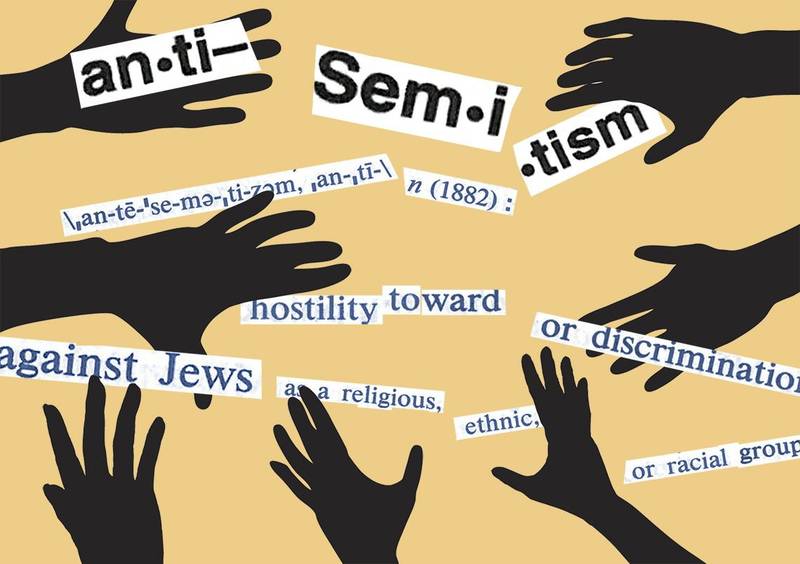Antisemitism Resources
Antisemitism: Resources and Reflections
 The best way to combat Jew hatred and antisemitism is to learn, and speak out.
The best way to combat Jew hatred and antisemitism is to learn, and speak out.
Below you will find:
1. Historic Tropes and Themes of Antisemitism
2. Modern manifestations of Historic Tropes
3. Video resources
4. Links to helpful articles
Video about Antisemitism with Sources to help Identify
A Brief History
A Video Definition
What is Antisemitism: Tropes and Themes of Hatred
International Holocaust Remembrance Alliance: Working Definition of Antisemitism
“Antisemitism is a certain perception of Jews, which may be expressed as hatred toward Jews. Rhetorical and physical manifestations of antisemitism are directed toward Jewish or non-Jewish individuals and/or their property, toward Jewish community institutions and religious facilities.”
Common Tropes in Anti-Semitism
Anti-Semitism – hostility, prejudice and discrimination against Jews – is one of the oldest forms of hatred in human society. It has persisted for thousands of years. Some of the themes of Anti-Semitism have been surprisingly consistent, re-emerging in different eras. This list of Anti-Semitic tropes is adapted from the work of the Louis D. Brandeis Center for Human Rights under Law.
1. Demonization Since the beginning of Christianity, influential figures in Christian theology have associated Jews with the devil or with demonic elements. During the Middle Ages, Jews were frequently described as children of the devil, often portrayed with horns and bulging eyes, and associated with Satanic attributes, such as arrogance and devious logic. In the contemporary world, these images are reflected in depictions of Jews with malevolent characteristics. This can be seen in caricatures of Israeli and Jewish public figures depicted as devils or demons.
2. Deicide Myth From the early years of Christianity, Jews have been condemned for rejecting Jesus. Worse, some Christians have condemned Jews for killing the Christian messiah and have held Jews responsible. This view is associated with the belief that God has caused Jews to continue to exist in a wretched state as evidence of the moral superiority of Christianity and to foreshadow the final triumph of Christianity at the end of days. In modern times, hostility to Jews is often seen in descriptions of Jews as evil, power hungry and treacherous.
3. Ritual Slaughter Since ancient times, Jews have been falsely accused of killing gentiles for ritual purposes. In Medieval Europe, beginning in the Twelfth Century, Jews were accused of using their victim’s blood to bake matzah. Historically, these false charges have frequently been followed by anti-Jewish riots and mass-murders. Today, echoes of this “blood libel” can be heard in allegations that Jews, especially in Israel, kill young gentile children for military or political purposes or in service of genocide. In one contemporary variation, Israelis are accused of kidnapping Palestinian children at night, murdering them, and selling their organs for profit.
4. The Wandering Jew The Wandering Jew was a common character in medieval Christian folklore. In the traditional formulation, a Jew who taunted Jesus on the way to his Crucifixion was cursed to roam the earth until the end of days. Today, this myth still echoes as the justification for taunting Jews, for example, in student-led kick-a-Jew or hit-a-Jew events held (despite official disapproval) at some American schools. Similarly, it can be seen in the notion that the Jews, alone among the peoples of the earth, do not deserve to have their own country. This can be seen in efforts to delegitimize the State of Israel and is reflected in references to Israel as “the Zionist entity.”
5. Carnality Early Christianity associated Jews with carnality (or lack of spirituality). Jews have been associated with lecherousness, greed, and stinginess. This is reflected in the use of the word “Jew” as a verb to describe harsh business practices. In contemporary times, carnal stereotypes are reflected in actions such as throwing coins at Jewish school children. A version of the carnal perception can be seen in the stereotype of the “Jewish American Princess” (or “JAP”) who is typically perceived as shallow, spoiled, selfish, vapid and materialistic.
6. Desecration Since the Middle Ages, Jews have been accused of tainting sacred objects or communal property. Beginning in the thirteenth century, Christians falsely charged Jews with reenacting the crucifixion by stealing and abusing host wafers, which represent the body and blood of Christ in Christianity. Since that time, Jews have been repeatedly charged with conspiring to desecrate holy sites or objects. Today, these allegations are reflected in accusations that Israelis are conspiring to destroy the Dome of the Rock in Jerusalem or other sacred sites.
7. Money and Criminality Since medieval times, Jews have been depicted as wealthy, powerful, menacing and controlling. Jews are stereotyped as demanding the sacrifice of others for their own greed. These images are often connected to supposed Jewish traits, such as malevolence, criminality, greediness, stinginess, and lying. Holocaust denial also tends to embody this view, especially when it presents the destruction of European Jewry as a global hoax perpetrated to defraud gullible humanity. Similarly, those who deny the very existence of contemporary anti-Semitism claim that charges of anti-Semitism are actually a hoax to deflect attention from Israel’s crimes. Holocaust inversion, which attributes Nazi characteristics to contemporary Jews, is similar. This can be seen when Jews and Israel are compared with Nazis when Jews are derogated as “Nazi Zionists.” In a softer form of this accusation, Israel is compared to the South Africa’s apartheid state.
8. Global Conspiracy Jewish conspiracy theories go back to the New Testament’s charge that the Jewish rabbinic authorities called for Jesus’ arrest and execution. In its modern form, such conspiracy theories claim that “the Jews” or “Zionists” make up a powerful, secret, global cabal that manipulates governments, banks, the media, and other institutions for evil purposes. Many conspiracies refer to The Protocols of the Elders of Zion, a fraudulent Russian document published in 1904 that claims to be a Jewish plan to take over the world. Conspiracy theories accuse Jews of starting all modern wars and can be seen in accusations that Israel or the Jewish people are responsible for virtually any contemporary catastrophe, such as the 9/11 attack on the World Trade Center.
Modern Examples of Tropes
In addition to the historic tropes above, here are some examples of modern manifestations of these tropes:
Contemporary examples of antisemitism (emphasis added) in public life, the media, schools, the workplace, and in the religious sphere could, taking into account the overall context, include, but are not limited to:
- Calling for, aiding, or justifying the killing or harming of Jews in the name of a radical ideology or an extremist view of religion.
- Making mendacious, dehumanizing, demonizing, or stereotypical allegations about Jews as such or the power of Jews as collective — such as, especially but not exclusively, the myth about a world Jewish conspiracy or of Jews controlling the media, economy, government or other societal institutions.
- Accusing Jews as a people of being responsible for real or imagined wrongdoing committed by a single Jewish person or group, or even for acts committed by non-Jews.
- Denying the fact, scope, mechanisms (e.g. gas chambers) or intentionality of the genocide of the Jewish people at the hands of National Socialist Germany and its supporters and accomplices during World War II (the Holocaust).
- Accusing the Jews as a people, or Israel as a state, of inventing or exaggerating the Holocaust.
- Accusing Jewish citizens of being more loyal to Israel, or to the alleged priorities of Jews worldwide, than to the interests of their own nations.
- Denying the Jewish people their right to self-determination, e.g., by claiming that the existence of a State of Israel is a racist endeavor.
- Applying double standards by requiring of it a behavior not expected or demanded of any other democratic nation.
- Using the symbols and images associated with classic antisemitism (e.g., claims of Jews killing Jesus or blood libel) to characterize Israel or Israelis.
- Drawing comparisons of contemporary Israeli policy to that of the Nazis.
- Holding Jews collectively responsible for actions of the state of Israel.
ADL resources and articles
Please read this helpful and informative article about how antisemitic tropes have creeped their way into "normal" life (not just virulent hate speech). ADL Article
On line Gaming and Hate
https://www.adl.org/resources/report/hate-no-game-hate-and-harassment-online-games-2022?utm_campaign=hateolgames2022&utm_medium=email&utm_source=whole&utm_content=e01
Mon, October 27 2025
5 Cheshvan 5786
Live from the bimah on YouTube!
Donations
Make a donation to Congregation Or Ami
Payments
Make a payment on your account
Gift Shop
Congregation Or Ami has a gift shop!
Please contact the office at (610) 828-9066 or office@or-ami.org if you are looking for something special for your home or a gift for a friend or loved one.
Contact Information
Privacy Settings | Privacy Policy | Member Terms
©2025 All rights reserved. Find out more about ShulCloud



